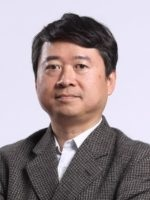Optical Coherence Tomography: Technologies and Challenges
Nanophotonics modelling for 21St century applications is becoming vital. The computational modeling provides a fundamental understanding of the relying physics behind the operation of photonic devices. However, computational modeling is still a challenge as some of the existing modeling techniques fail to capture the correct behavior of nano-photonic devices. In this regard, this talk will introduce an overview of the existing computational modeling tools for analyzing photonic devices, in general, and highlighting their salient features and shortcomings. It is well known that “plasmonics” plays a vital role now in localising the optical field beyond the diffraction limit and hence in integrated optics. Therefore, the talk will focus on plasmonics modeling issues and the failure of the classical electromagnetic solvers to accurately characterize the nano-plasmonic devices. Therefore, new accurate and stable beam propagation method will be introduced for analyzing plasmonics in the classical regime. The rigor of this approach is mainly because of relying on the finite elements method and the twice faster Blocked Schur algorithm which can exactly represent all the wide spectrum of radiation, evanescent, and surface modes produced by the strong discontinuity between metal and its surroundings. Moreover, in merging quantum plasmonic devices, it becomes essential to introduce “Quantum Corrected Model (QCM)” in order to accurately model these devices, and the basics of QCM will be also discussed.
Date and Time
Location
Hosts
Registration
-
 Add Event to Calendar
Add Event to Calendar
Loading virtual attendance info...
- Contact Event Hosts
-
Please contact Chair, Victorian IEEE Section Electron Devices and Photonics Society Joint Chapter: Dr Yuvaraja Visagathilagar, Email: yuvaraja@ieee.org
Speakers
 Prof Huang of National Taiwan University
Prof Huang of National Taiwan University
Optical Coherence Tomography: Technologies and Challenges
Nanophotonics modelling for 21St century applications is becoming vital. The computational modeling provides a fundamental understanding of the relying physics behind the operation of photonic devices. However, computational modeling is still a challenge as some of the existing modeling techniques fail to capture the correct behavior of nano-photonic devices. In this regard, this talk will introduce an overview of the existing computational modeling tools for analyzing photonic devices, in general, and highlighting their salient features and shortcomings. It is well known that “plasmonics” plays a vital role now in localising the optical field beyond the diffraction limit and hence in integrated optics. Therefore, the talk will focus on plasmonics modeling issues and the failure of the classical electromagnetic solvers to accurately characterize the nano-plasmonic devices. Therefore, new accurate and stable beam propagation method will be introduced for analyzing plasmonics in the classical regime. The rigor of this approach is mainly because of relying on the finite elements method and the twice faster Blocked Schur algorithm which can exactly represent all the wide spectrum of radiation, evanescent, and surface modes produced by the strong discontinuity between metal and its surroundings. Moreover, in merging quantum plasmonic devices, it becomes essential to introduce “Quantum Corrected Model (QCM)” in order to accurately model these devices, and the basics of QCM will be also discussed.
Biography:
Sheng-Lung Huang, Graduate Institute of Photonics and Optoelectronics, National Taiwan University, is visiting the Faculty of Physics and Astronomy as ASP Visiting Professor in May 2014. During his stay he will give two lectures.
Sheng-Lung Huang received the B.S. degree from the Department of Electrical Engineering, National Taiwan University in 1986, and the M. S. and Ph. D. degrees from the Department of Electrical Engineering, University of Maryland, College Park in 1990 and 1993, respectively. He joined the Graduate Institute of Photonics and Optoelectronics (GIPO) and the Department of Electrical Engineering, National Taiwan University in 2006. He served as the Chairman/Director of GIPO from August 2007 to July 2010. Prior to joining the National Taiwan University, he served as Chairman/Director of the Institute of Electro-Optical Engineering, National Sun Yat-Sen University from April 2003 to Jan. 2006. His expertise is on fiber based photonics and tomography technologies.
Dr. Huang is a senior member of the IEEE. He served as the Chairman of the IEEE Photonics Society Taipei Chapter, 2005 - 2006, and was a Topical Editor of Optics Letters in the area of optical measurements, components, and devices, 2005 - 2011. He has served as a steering board member of the European Master of Science in Photonics (EMSP) consortium. Dr. Huang was the recipient of Ministry of Education Outstanding University/Industry Cooperation Award, 1997. He has jointly awarded with his students on Chimei Innovation Excellence Award (2010) and Optical Communications Elite Award (2005).
Fields of specialty:
- Broadband light sources for optical coherence tomography
- Crystalline fiber based lasers and amplifiers
Email:
Address:Taiwan, Taiwan

